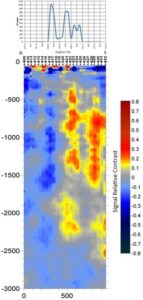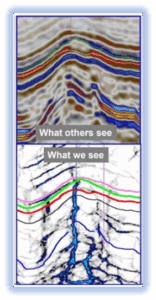After gaining sufficient understanding of a potentially hydrogen conducting structure within the AOI, next step is to obtain more spatial knowledge about it before planning to access it with an exploration well. For this purpose, we employ several time-proven methods aiming to assess the structure shape, depth, degassing nature and flow rate, as well as several other parameters crucial for its further development.
It’s worthwhile to note that these geophysical technologies are quite well known and proven through the decades of application in the field. However, the interpretation of their results may appear a bit un-orthodox to a by-stander. Yet, the conclusions drawn from this stage are perfectly logic, since they are based on the fundamental chemical and physical properties of hydrogen.
Unlike traditional seismic, the Duplex Wave Migration (DWM) technique is suitable for imagery of tectonic and structural (sub)vertical features dipping @60° through 90°. It is capable of fluid flow systems detection and their quantification through applying the fluid dynamics.
DWM may be used for re-migration and re-interpretation of existing raw seismic data, saving costs and time. This method is applicable for detection and visual description of natural hydrogen de-gassing systems in a variety of geologic situations.
Additional benefits include: prognostic capabilities, 4D developmental patterns, etc.


